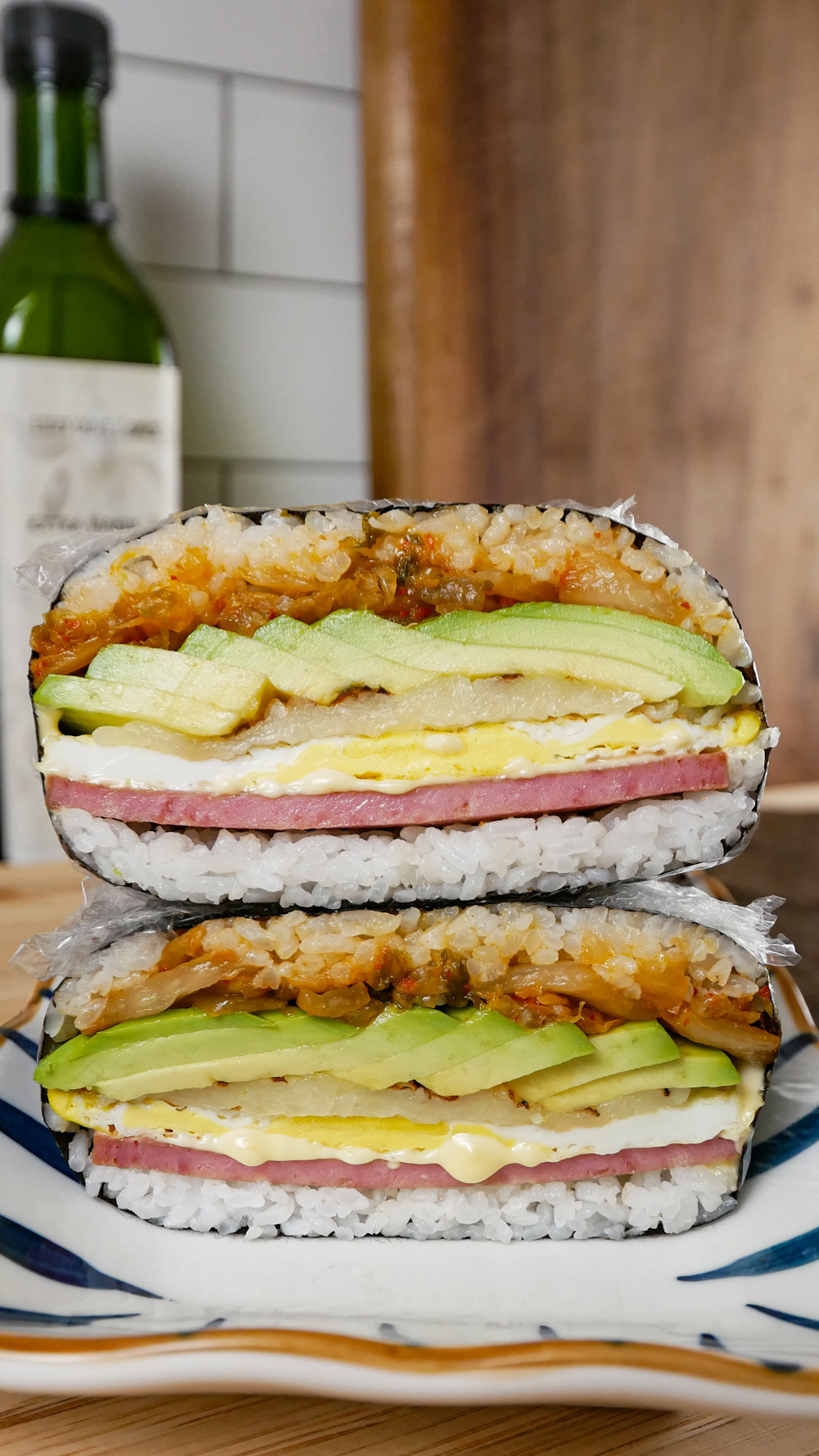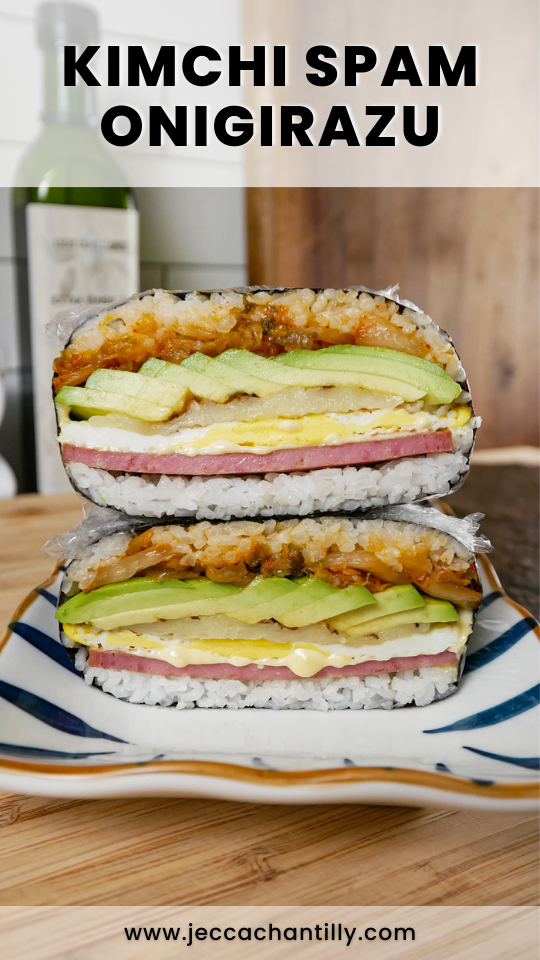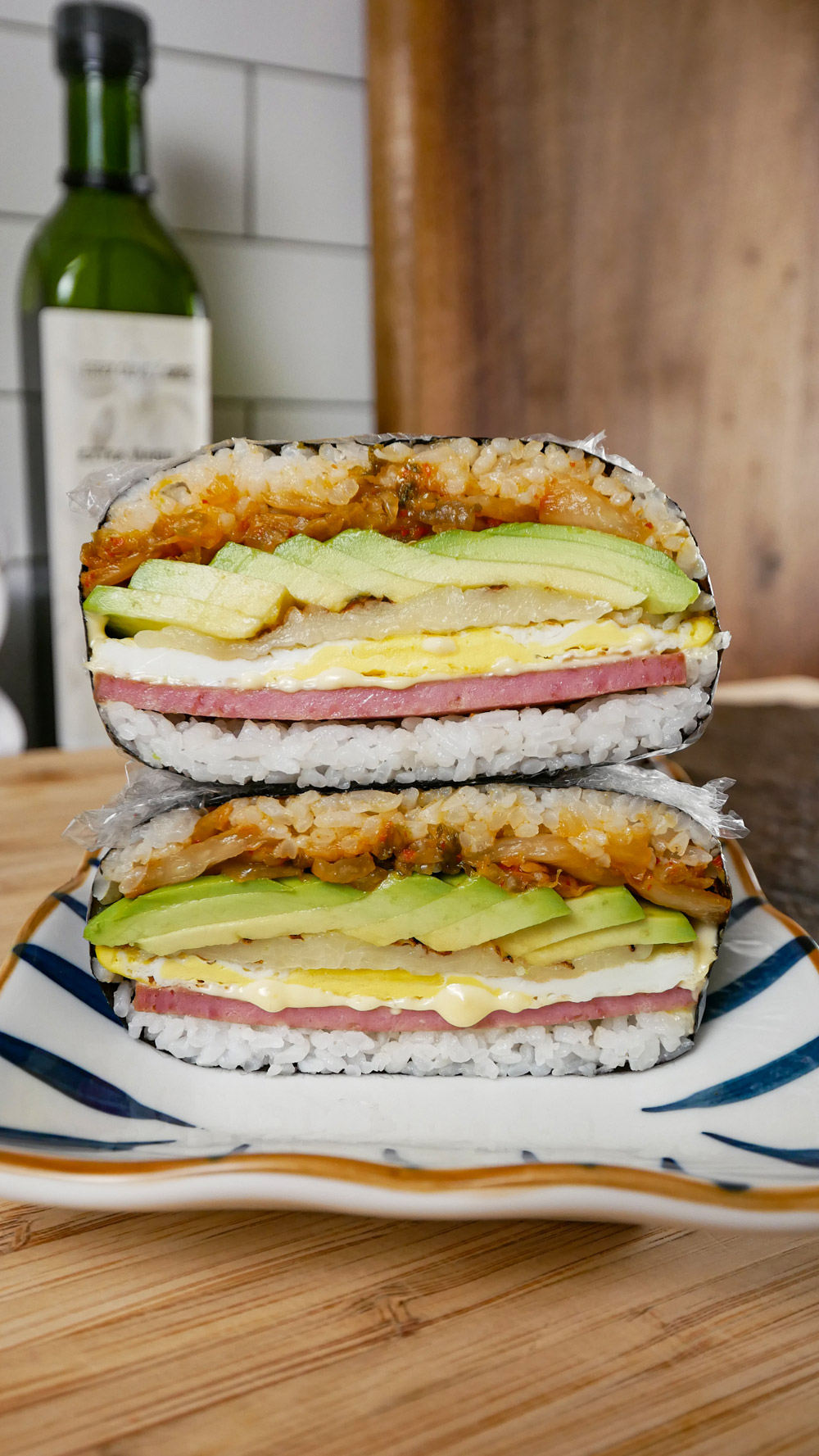If you’re not familiar with onigirazu, it is a variation of onigiri or Japanese rice balls. While rice is one of the main components used to make onigirazu, it’s quite different than an onigiri or rice ball. To put things into perspective, imagine a sandwich but instead of using bread, roasted seaweed is filled with rice and various fillings. Now, these fillings are customizable based on what you like, and for this recipe, I’m using a combination of all my favorite ingredients which include spam, kimchi, avocado, and a beautifully cooked egg!
If you’re looking for inspiration for easy and delicious onigiri, check out my most popular recipes below!
Why you’ll love this recipe
Due to their compact size and ease of preparation, this onigirazu is the perfect lunch, dinner, or snack! It’s great for hiking, picnics, lunchboxes, road trips, or whenever you’re on the go. As mentioned above, the filling can be tailored to your preferences however, in my opinion, the combination of the savory spam, tangy kimchi, creamy avocado, and perfectly cooked egg, all balanced with the rice and subtle umami notes of roasted seaweed is a burst of flavor in every bite.
Spam, kimchi, and egg are a popular combination in Korean cuisine, and this onigirazu is no exception! If you’re looking for a quick and filling lunch, snack, or dinner, this kimchi egg and Spam onigirazu recipe makes the perfect meal. The great thing about this is it only takes 20 minutes to make, so you can easily prepare it whenever you like!
How do I prepare Kimchi Egg & Spam Onigirazu?
Making kimchi egg & spam onigirazu requires minimal effort for maximum flavor. To prepare it, follow the recipe below:
Step 1: Cook the Spam
In a pan, heat 1/2 tablespoon of oil over medium heat. Add Spam and cook until slightly browned and crusted on the outside, about 2 to 3 minutes. Remove it from the heat and set it aside.
Step 2: Cook the egg
In the same pan, add 1 tablespoon of oil and crack an egg. Try to shape the egg into a square shape so it’s easier to assemble later. Cook it to your desired doneness, remove it from the pan, and set it aside.
Step 3: Cook the kimchi
Using the same pan again, add the remaining 1/2 tablespoon of oil. Toss in the kimchi and sugar and sauté for 2 to 3 minutes, or until the kimchi is slightly charred.
Step 4: Prepare your assembling area
To assemble, place a piece of plastic wrap on your surface area. It should be bigger than the roasted seaweed (nori) sheets.
Step 5: Assemble the onigirazu
Arrange the roasted seaweed sheet on top, making sure the placement is like a diamond. Then in the center, layer it with 1/2 cup of rice, Spam, mayo, egg, cheese (*optional* – use a blowtorch to melt the cheese slightly), avocado, kimchi, and the remaining 1/2 cup of rice.
Step 6: Wrap the onigirazu
Use the plastic wrap to carefully wrap the onigirazu from left to right, then top to bottom, which will help hold everything together. Be sure to wrap the onigirazu tightly so it stays in place.
(You can also watch the video below to see how I do this step. 😁)
Step 7: Slice and serve
Slice the onigirazu in half and serve. Enjoy!
Cooking Tips for Kimchi Egg & Spam Onigirazu
Whether you’re a novice cook or a professional chef, this onigirazu is easy to prepare! However, here are some helpful tips to keep in mind to make the most delicious onigirazu every time!
- For best results, I highly recommend using short-grain or medium-grain rice because they are starchy and can hold shape better than long-grain rice.
- While I kept it simple with the rice without adding any additional seasonings, you can make sushi vinegar for the rice by mixing together 2 tablespoons of rice vinegar, 1 tablespoon of sugar, and ½ teaspoon of salt. Start by adding half of the sushi vinegar and taste as you go.
- I recommend using well-fermented kimchi for the best flavor. It should be extra sour and tangy! If you only have fresh kimchi like, Geotjeori Kimchi, add a splash of white vinegar when cooking it in the fry pan.
- Sugar is added to the kimchi to help balance out the tanginess and saltiness of the kimchi. If your kimchi is extremely fermented and sour, add a pinch more sugar. But remember, taste as you go and make it how you like!
- The plastic wrap will help you wrap and assemble the onigirazu easier and mess-free! Just be sure to lay a big piece of plastic wrap on your surface area before you start assembling.
Ingredients & Substitutions
Cooked rice: cooked rice is the base for this dish which makes it filling. Ideally, you’ll want to use short-grain rice or medium-grain rice. I don’t recommend using long-grain rice like jasmine or basmati as they don’t contain enough starch.
Spam: spam adds a salty and umami flavor to the onigirazu and is a delicious combination of kimchi and egg. But you can switch it with any protein you like or skip it completely!
Mayo: mayo adds a rich and creamy texture to the onigirazu filling. It almost acts like a sauce that ties everything together. I prefer using Japanese mayo called Kewpie mayo because it is richer, creamier, and slightly sweeter than regular mayo.
Egg: egg adds a subtle richness to the onigirazu and helps to balance out the saltiness from the other components. Feel free to prepare it however you like – I like mine a little runny!
Shredded cheese: shredded cheese always makes any dish better. You can use any type of cheese you like, including parmesan, cheddar, or mozzarella. I recommend using a blow torch to melt the cheese while assembling.
Avocado: avocado adds a fresh and creamy texture to balance out the flavors of the onigirazu. Similar to the mayo, it helps to tie the components together.
Kimchi: kimchi adds a spicy and tangy element to the onigirazu and deliciously complements the spam and egg. Ideally, you want to use well-fermented sour kimchi. You can use your favorite brand of kimchi or make a batch at home using my Cabbage Kimchi recipe!
Sugar: cooking the kimchi with sugar helps to balance out the tangy and sour notes of the kimchi. It also helps to caramelize the kimchi, making it incredibly delicious! Feel free to use white or brown sugar for this recipe.
Roasted seaweed: also known as nori, roasted seaweed sheets are the vessels used to hold the rice and filling together so they’re compact and easier to eat. It also adds an umami flavor to complete the dish.
Neutral oil: any neutral oil will work well for cooking the spam, egg, and kimchi, including corn, canola, avocado, vegetable, sunflower, grapeseed, or peanut oil.
Ingredient Additions/Variations
If you want to experiment with other ingredients to level up your onigirazu, here are some of my recommendations!
- Crab sticks – crab sticks or imitation crab make great sushi rolls and onigiris, so it’s no surprise that their flavors will taste great on this onigirazu recipe. Make sure to slice them in half or shred them before assembling.
- Pineapple – pineapple may be the last ingredient to think of adding to onigirazu, but its tartness will complement well with the savoriness of the spam and sweet, spicy, and sour flavors of the kimchi. Use pineapple slices so they assemble easily into the onigirazu.
- Furikake – if you’re looking for that extra *oomph* in flavor, a sprinkle of furikake is exactly what you need. While there are different varieties, it’s typically made of a mixture of chopped seaweed, dried fish, sesame seeds, salt, and sugar. Simply mix it into the rice and that’s it!
Frequently Asked Questions
What does onigirazu mean?
When translated directly, onigirazu means “no shaping” or “no squeezing” in Japanese. Although onigirazu is similar to onigiri or Japanese rice balls, you don’t need to shape it into a triangle, hence the name. With onigirazu, you can still enjoy its components of rice, roasted seaweed, and fillings of your choice!
What type of rice should I use to make onigirazu?
Ideally, you’d want to use short-grain or medium-grain rice due to their high starch content. Their high starch content means the rice is sticky when cooked, making it easier to hold shape. I don’t recommend using long-grain rice like jasmine rice or basmati rice as they are not starchy enough.
Can I use day-old rice for onigirazu?
Technically, you can use day-old rice for making onigirazu as long as it’s reheated before assembling. To reheat the rice, simply microwave it for a few minutes until thoroughly heated. Just make sure to allow the rice to come to room temperature before assembling. This will make assembling easier and you’ll avoid burning your fingers.
Can I make this vegetarian-friendly?
Yes, of course! To make this vegetarian-friendly, substitute the spam with grilled tofu and skip the egg, if desired. Feel free to add more vegetables like cucumbers, red bell peppers, or even hummus for a heartier meal.
Can I make onigirazu in advance?
While they’re best enjoyed fresh, you can absolutely make onigirazu in advance. Just be sure to wrap them tightly in plastic wrap and store them in the refrigerator. The plastic wrap will prevent the seaweed sheet and rice from drying out. I recommend enjoying them within a day.
Looking for more easy and delicious Japanese-inspired recipes?
1. Miso Udon Noodle Soup – if you can’t resist a delicious bowl of noodles, you have to try my miso udon noodle soup. It’s packed with fish cakes, tofu skin, and sauteed oyster mushrooms, enveloped by a robust and umami soup that’ll surely hit all the right spots.
2. Air Fryer Tonkatsu – if you like crispy tonkatsu but hate the grease that comes with its preparation, this air fryer alternative is the one! Cooking the pork katsu in an air fryer will result in a crunchy exterior and juicy interior without all the mess!
3. Spicy Salmon Poke Bowl – if you’re a seafood lover, this salmon poke bowl recipe is a must-try! It’s spicy, filling, and flavorful, and perfect with a bowl of rice.
4. Miso Marinated Cod – for a quick and delicious comforting dish, this recipe is hard to beat. The cod is marinated in umami-rich miso before broiling or baking for the perfect easy weeknight meal!
5. Japanese Egg Sandwich (Tamago Sando) – you can now recreate this convenience store staple at home with my creamy and delicious tamago sando recipe. The best part? It only takes 10 minutes to prepare!

Spam Onigirazu
Ingredients
- 1 cup cooked rice
- 1 slice Spam
- 1 tbsp mayo
- 1 egg
- 2 tbsp shredded cheese
- 1/4 avocado sliced
- 3 tbsp kimchi chopped
- 1/4 tsp sugar
- 1 sheet roasted seaweed
- 2 tbsp neutral oil divided
Instructions
- In a pan, heat 1/2 tablespoon of oil over medium heat. Add Spam and cook until slightly browned and crusted on the outside. Remove and set aside.
- In the same pan, add 1 tablespoon of oil and crack the egg. Try to shape the egg into a square shape so it's easier to assemble later. Cook to your desired doneness then remove and set aside.
- Using the same pan again, add the remaining 1/2 tablespoon of oil. Toss in the kimchi and sugar and sauté for 2 to 3 minutes, or until the kimchi is slightly charred.
- To assemble, place a piece of plastic wrap on your surface area. It should be bigger than the nori sheets.
- Place the nori sheet on top then layer it with 1/2 cup of rice, Spam, mayo, egg, cheese (*optional* – use a blow torch to slightly melt the cheese), avocado, kimchi and the remaining 1/2 cup of rice.
- Carefully wrap the onigirazu from left to right then top to bottom while using the plastic wrap to hold everything together. Be sure to wrap the onigiriazu tightly so it stays in place.
- Slice the onigriazu in half and enjoy!
Pin & save this recipe for later!

